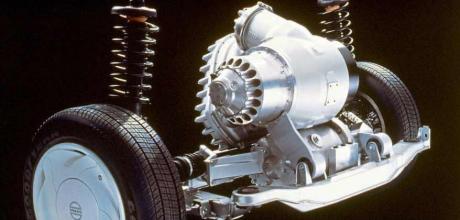Jim Randle’s gas turbine hybrid

Now that hybrids have joined Jaguar’s line up – including the E-PACE featured on – I’m reminded that the concept of a Jaguar powered by an internal combustion engine working alongside an electric motor goes much further back.
In the late Eighties, Jaguar created an advanced engineering group under engineering director Jim Randle’s leadership. Its remit was to look at advanced vehicle engineering in all its forms, but particularly powertrains. The team would investigate hybrids long before the idea had become universally accepted.
The concept solved a potential problem for Jaguar because there was, at the time, impending legislation in California for ultra-low-emissions. Hybrids did offer a chance of achieving this – especially when using an electric drive charged by a natural gas turbine.
Jim had believed in gas turbines since his apprenticeship at Rover, during the early Sixties, when he was involved with its gas turbine-powered LeMans car. Gas turbines are small, quiet, have a single moving part and operate at one speed, resulting in complete combustion that produces hugely reduced amounts of emissions. In fact, Jim was so convinced by the idea that when he left Jaguar in around 1991 and became professor of mechanical engineering at Birmingham University, he continued with his research.
He went on to explain the idea to several European car manufacturers. It was Volvo that became interested in his work, which culminated in the ECC concept of 1992 that featured a small gas turbine powering an electric motor mounted on the rear axle (pictured). But, and all too reminiscent of his later years at Jaguar, the project was canned when the Swedish company was bought out by Ford in the late Nineties.
Yet, there’s no denying that Jim was ahead of the curve. The current drive for zero emissions and reducing climate change means that the chance of cars using internal combustion engines powered by fossil fuels in the medium term is unlikely. But, the storage of energy in batteries is the weakest part of all electric vehicles – resulting in a limited range and a relatively slow recharge. To counter this, I know most of the industry is working on hybrids where either compressed air, or more likely hydrogen, become the means to having an unlimited range. So, whether they are powered by air or gas, I wouldn’t be surprised to see turbines fit into the future hybrid equation because I think they make a lot of sense. Just as they did to Jim Randle, 40 years ago.
JIM HAD BELIEVED IN GAS TURBINES SINCE HIS APPRENTICESHIP AT ROVER, WHEN HE WAS INVOLVED WITH ITS GAS TURBINE-POWERED LE MANS CAR

